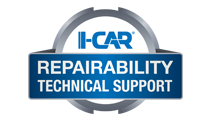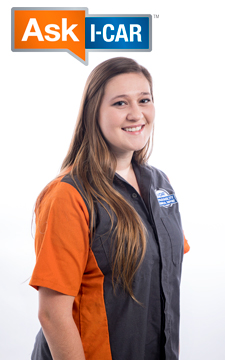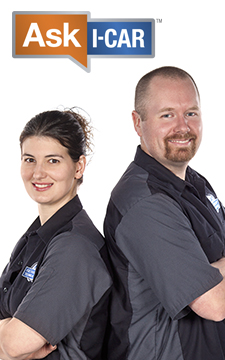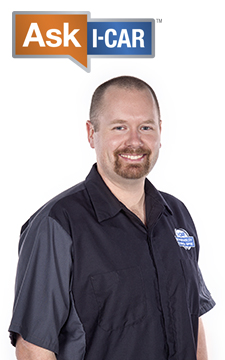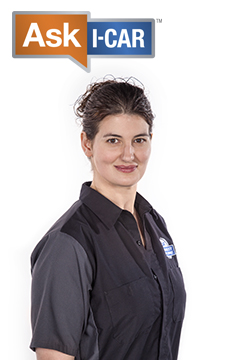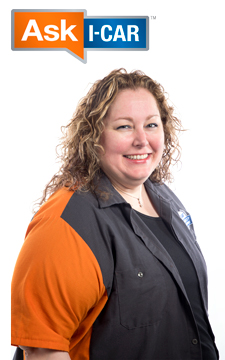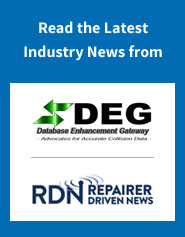The Aluminum Difference
What's Iowa Got To Do With It?
by Jason Bartanen
We've seen a lot of changes in vehicle technology over the years. With each of these changes come new challenges and new opportunities. When the unibody vehicle was introduced, repair professionals were required to change their approach to collision repair, from damage analysis through the repair process. With the introduction of GMA (MIG) welding, additional requirements for repairs included new training and equipment. And passive restraints systems presented a completely different type of challenge, involving electronics and diagnostics.
Since then, we've seen advanced braking systems, advanced high- and ultra-high-strength steels, new types of plastic and composite parts, and a plethora of advanced safety systems. With each new advancement, collision repairers have been continuously challenged to adapt; and it's time to get ready to adapt again. High-production vehicles with extensive use of aluminum are coming; it's time to acknowledge the reality of this imminent change and get ready to tackle it as another opportunity. "Aluminum isn't difficult; it's just different." We first heard this statement in the 1990s during the development of the Ford P2000 concept vehicle; a collaborative effort between the Aluminum Association and Ford Motor Company. Many collision repair professionals began to look into the impending challenges we'd soon be facing, I-CAR expanded its aluminum course offerings, and started to see an expansion in the availability of automotive aluminum MIG pulse welding equipment. However, when the steel manufactures recognized the charge that aluminum was about to make, they acted quickly and formed the UltraLight Steel Auto Body (ULSAB) consortium; that led to the creation of the ULSAB vehicle structure. The infusion of aluminum into the automobile design and development industry had been slowed; temporarily.
So, "what's Iowa got to do with it?" In March of 2012, Alcoa executives, along with the Governor of Iowa, broke ground in Davenport on a $300 million dollar expansion at their Davenport Works facility to "meet rising demand for aluminum from the automotive market."While there isn't a shortage of aluminum-intensive vehicles (Jaguar F-Type, XJ and XK, Land Rover Range Rover and Range Rover Sport, Audi A8 and R8 are just a few examples) and there are a lot of aluminum closure panels, the Iowa expansion is a strong indicator that we will soon see more aluminum than ever. The new Chevrolet Corvette Stingray is built on an all-aluminum space frame and rumors are running rampant about other potential high-volume vehicles that will employ aluminum-intensive body structures. At a minimum, we will see more aluminum hoods, doors, and other closure panels. According to the latest Ducker Report, a survey of auto OEMs and their planned use of materials, the amount of aluminum used in cars in North America "“ already the #2 material in a car "“ is going to nearly double by 2025.
So what does it all mean to collision repair professionals? It's time to adapt, again. Much like shops had to "find a place" to install a three-dimensional measuring system, they'll need to develop an isolated area to repair aluminum-intensive vehicles, to avoid potential galvanic corrosion issues. Similar to making investments in GMA (MIG) and squeeze-type resistances spot welding (STRSW) equipment, they'll need to invest in GMA (MIG) welders capable of aluminum pulse welding and in rivet guns to properly repair tomorrow's aluminum-intensive vehicles. There will also be a number of vehicles that will be built with a combination of aluminum and steel structures (Audi TT and Porsche 911, for example) that will require repair professionals to ensure they're using the proper adhesives and techniques to minimize the potential of galvanic corrosion.
Aluminum-intensive vehicles will also force professionals to adapt their approach to damage analysis "“ no different than as with high-strength steels. Identifying castings from stampings and extrusions, and knowing the repairability limits of each, will be essential to writing a complete and accurate damage assessment. Proper identification of parts and their repairability limits will minimize supplements and improve cycle time. Technicians will also have to be able to identify the types of aluminum and choose the proper attachment method, based on the vehicle maker's recommendation. Proper electrode selection is essential for performing welds that will stand the test of time, and proper rivet removal and installation are paramount to a complete and safe repair. Having the proper tools, equipment, and materials, along with the knowledge gained from understanding proper training and repair techniques, are the only way to achieve complete and safe repairs.
The technologies found in today's vehicles are evolving at a record pace and collision professionals must continuously adapt to meet the opportunities. More aluminum-intensive vehicles will be on the road in the next 12 months and the time to start adapting is now. Fortunately for all of us, aluminum isn't difficult; it's just different.
Additional I-CAR Collision Repair News you may find helpful:
Related I-CAR Courses
Article validated in 2025
-
Toyota/Lexus/Scion Position Statement: Pre- and Post-Repair System Scanning
Thursday, 28 July 2016
As the industry continues to ask if pre- and post-repair system scanning is necessary, Toyota/Lexus/Scion provides their answer.
-
Pre- and Post-Repair System Scanning Statements
Wednesday, 9 January 2019
Are you wondering if a particular OEM or organization has a published statement on pre-repair and post-repair scanning? We have compiled a list of most of the statements on the subject, so you can...
-
ADAS, Calibration, And Scanning Article Hotspot
Monday, 14 January 2019
Since advanced driver assistance systems (ADAS), scanning, and calibration first started becoming relevant, members of the collision repair industry have required as much knowledge as possible on...
-
Honda/Acura Position Statement: Pre- and Post-Repair System Scanning - UPDATE
Wednesday, 22 May 2019
Honda /Acura has updated their position statement on pre- and post-repair scanning to give more clarification on what is expected for scanning.
-
BMW Position Statement: Pre- and Post-Repair System Scanning - UPDATE
Friday, 10 April 2020
BMW has released a position statement related to pre- and post-repair system scanning. The statement applies to All vehicles equipped with on board diagnostics II (OBD II).
-
Quickly Identifying Outer Quarter Panels w/Rolled Hem Flanges
Monday, 5 March 2018
The I-CAR best practice article, Recycled Outer Quarter Panels w/Rolled Hem Flanges has gotten a lot of interest from the collision repair industry. It’s important to know which vehicles are...
-
General Motors Position Statement: Pre- and Post-Repair System Scanning
Friday, 21 October 2016
As the industry continues to ask, are pre- and post-repair scans necessary, General Motors provides their answer.
-
Restraints Wiring Repairs
Monday, 23 May 2016
Over the past few months, we've been sharing OEM position statements on restraints wiring repairs. Now we're bringing them all together in one place for easy reference.
-
FCA/Stellantis Position Statement: Pre- and Post-Repair System Scanning
Thursday, 9 June 2016
FCA/Stellantis has released a position statement related to pre- and post-repair system scanning.
-
Typical Calibration Requirements For Forward Radar Sensors
Wednesday, 12 October 2016
Technicians should be aware of what’s required to keep advanced driver assistance systems (ADAS) running safely after a collision. Whether that be aiming a camera, which can cause a system to not...
-
App-Based Connected Services Considerations: BMW
Wednesday, 10 December 2025
Have you had an experience where the vehicle notified the owner that it was being moved while it was in your repair facility? App-based connected services are available from many vehicle makers and...
-
Digital Key Considerations: BMW
Wednesday, 10 December 2025
The intermingling of technology and automobiles continues, with digital key offerings from most vehicle makers. Digital keys utilize smartphone technology to expand vehicle access and owner...
-
I-CAR Repairers Realm: RTS 2025 Year In Review - Coming Soon
Tuesday, 9 December 2025
I-CAR is having a discussion on the Repairability Technical Support (RTS) 2025 year in review.
-
Mercedes-Benz Vehicles On The RTS OEM Calibration Requirements Search
Thursday, 4 December 2025
Mercedes-Benz models are now listed in the OEM Calibration Requirements Search page on the RTS website. You're going to notice a difference between other vehicle search results and Mercedes-Benz...
-
I-CAR Repairers Realm - New In 2026: Mixed Attachment Methods And Steel Sectioning Recertification - Now Available
Monday, 1 December 2025
I-CAR had a discussion on the new Mixed Attachment Methods course launching in 2026.
-
Repairer Driven News: SCRS OEM Collision Repair Technology Summit Sessions
Monday, 1 December 2025
Repairer Driven News published three articles highlighting safety inspection topics that took place during the Collision Repair Specialists (SCRS) OEM Collision Repair Technology Summit at the 2025...
-
I-CAR Audi Collision Repair And Electromechanical Repair Overview Courses
Tuesday, 25 November 2025
I-CAR has developed courses that provide an overview of collision repair and electromechanical repair for current Audi vehicles.
-
SEMA 2025: Ford/Lincoln Presentations
Monday, 24 November 2025
I-CAR had numerous presentations at the 2025 SEMA show. Ford/Lincoln delivered two presentations.
-
Honda/Acura Rear View And 360 View Cameras - UPDATE
Friday, 21 November 2025
While searching for information on advanced driver assistance systems (ADAS) on an OEM repair information site, you may come across unique calibration procedures or events. These events can vary by...
-
Ford/Lincoln Position Statement: OEM Structural Fasteners And Adhesives - UPDATE
Thursday, 20 November 2025
Ford/Lincoln has released a position statement about the use of OEM structural fasteners and adhesives.
- 2025
- December 2025 (6)
- November 2025 (12)
- October 2025 (13)
- September 2025 (11)
- August 2025 (12)
- July 2025 (11)
- June 2025 (11)
- May 2025 (11)
- April 2025 (13)
- March 2025 (12)
- February 2025 (11)
- January 2025 (12)
- 2024
- December 2024 (8)
- November 2024 (10)
- October 2024 (13)
- September 2024 (10)
- August 2024 (12)
- July 2024 (11)
- June 2024 (9)
- May 2024 (13)
- April 2024 (12)
- March 2024 (12)
- February 2024 (12)
- January 2024 (9)
- 2023
- December 2023 (8)
- November 2023 (12)
- October 2023 (11)
- September 2023 (11)
- August 2023 (12)
- July 2023 (9)
- June 2023 (11)
- May 2023 (12)
- April 2023 (11)
- March 2023 (12)
- February 2023 (10)
- January 2023 (11)
- 2022
- December 2022 (11)
- November 2022 (12)
- October 2022 (11)
- September 2022 (13)
- August 2022 (11)
- July 2022 (10)
- June 2022 (13)
- May 2022 (11)
- April 2022 (12)
- March 2022 (10)
- February 2022 (11)
- January 2022 (13)
- 2021
- December 2021 (13)
- November 2021 (11)
- October 2021 (13)
- September 2021 (14)
- August 2021 (12)
- July 2021 (15)
- June 2021 (17)
- May 2021 (12)
- April 2021 (14)
- March 2021 (20)
- February 2021 (14)
- January 2021 (14)
- 2020
- December 2020 (13)
- November 2020 (17)
- October 2020 (12)
- September 2020 (14)
- August 2020 (11)
- July 2020 (18)
- June 2020 (14)
- May 2020 (14)
- April 2020 (19)
- March 2020 (12)
- February 2020 (13)
- January 2020 (14)
- 2019
- December 2019 (13)
- November 2019 (19)
- October 2019 (25)
- September 2019 (20)
- August 2019 (22)
- July 2019 (23)
- June 2019 (20)
- May 2019 (19)
- April 2019 (20)
- March 2019 (20)
- February 2019 (18)
- January 2019 (17)
- 2018
- December 2018 (18)
- November 2018 (19)
- October 2018 (17)
- September 2018 (16)
- August 2018 (21)
- July 2018 (20)
- June 2018 (21)
- May 2018 (17)
- April 2018 (19)
- March 2018 (21)
- February 2018 (15)
- January 2018 (20)
- 2017
- December 2017 (13)
- November 2017 (15)
- October 2017 (19)
- September 2017 (20)
- August 2017 (19)
- July 2017 (18)
- June 2017 (19)
- May 2017 (19)
- April 2017 (13)
- March 2017 (18)
- February 2017 (10)
- January 2017 (11)
- 2016
- December 2016 (9)
- November 2016 (14)
- October 2016 (21)
- September 2016 (10)
- August 2016 (11)
- July 2016 (8)
- June 2016 (10)
- May 2016 (5)
- April 2016 (11)
- March 2016 (12)
- February 2016 (10)
- January 2016 (8)
- 2015
- December 2015 (9)
- November 2015 (6)
- October 2015 (8)
- September 2015 (7)
- August 2015 (11)
- July 2015 (7)
- June 2015 (5)
- May 2015 (7)
- April 2015 (8)
- March 2015 (8)
- February 2015 (9)
- January 2015 (10)
- 2014
- December 2014 (12)
- November 2014 (7)
- October 2014 (11)
- September 2014 (10)
- August 2014 (9)
- July 2014 (12)
- June 2014 (9)
- May 2014 (12)
- April 2014 (9)
- March 2014 (6)
- February 2014 (1)
- January 2014 (26)
